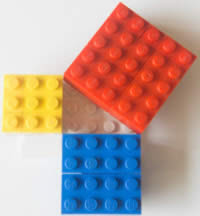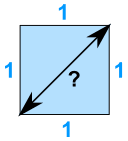The Pythagorean Theorem Helps Calculate The Size Of Which Shape?
Pythagoras' Theorem

Pythagoras
Over 2000 years ago there was an amazing discovery well-nigh triangles:
When a triangle has a right angle (90°) ...
... and squares are fabricated on each of the three sides, ...
geometry/images/pyth1.js
... so the biggest square has the exact same area equally the other two squares put together!

It is called "Pythagoras' Theorem" and can exist written in one brusque equation:
a2 + b2 = c2

Annotation:
- c is the longest side of the triangle
- a and b are the other 2 sides
Definition
The longest side of the triangle is chosen the "hypotenuse", so the formal definition is:
In a correct angled triangle:
the square of the hypotenuse is equal to
the sum of the squares of the other ii sides.
Sure ... ?
Allow'south come across if it actually works using an instance.
Instance: A "3, four, 5" triangle has a correct angle in information technology.
 | Let's cheque if the areas are the same: three2 + 4two = 5ii Calculating this becomes: 9 + sixteen = 25 It works ... like Magic! |

Why Is This Useful?
If we know the lengths of two sides of a right angled triangle, we can find the length of the third side. (Merely call up information technology merely works on right angled triangles!)
How Exercise I Use it?
Write it down as an equation:
 | a2 + bii = ctwo |
And so we use algebra to detect any missing value, every bit in these examples:
Example: Solve this triangle

Start with: atwo + b2 = cii
Put in what nosotros know: 52 + 122 = ctwo
Calculate squares: 25 + 144 = c2
25+144=169: 169 = c2
Swap sides: c2 = 169
Square root of both sides: c = √169
Calculate: c = 13

Read Builder'south Mathematics to run into practical uses for this.
Besides read well-nigh Squares and Square Roots to find out why √169 = 13
Example: Solve this triangle.

Offset with: atwo + bii = cii
Put in what we know: ninetwo + b2 = xvii
Calculate squares: 81 + bii = 225
Have 81 from both sides: 81 − 81 + b2 = 225 − 81
Summate: b2 = 144
Square root of both sides: b = √144
Calculate: b = 12
Example: What is the diagonal distance across a square of size 1?

Start with: atwo + b2 = c2
Put in what nosotros know: onetwo + one2 = c2
Calculate squares: one + 1 = c2
1+one=ii: 2 = c2
Swap sides: c2 = two
Foursquare root of both sides: c = √2
Which is about: c = 1.4142...
It works the other way around, as well: when the 3 sides of a triangle make a2 + bii = ctwo , then the triangle is correct angled.
Case: Does this triangle have a Right Angle?

Does a2 + b2 = c2 ?
- a2 + bii = x2 + 242 = 100 + 576 = 676
- c2 = 262 = 676
They are equal, so ...
Yes, it does take a Right Angle!
Instance: Does an viii, 15, 16 triangle have a Correct Angle?
Does 8 2 + 15 ii = 16 2 ?
- 8ii + xv2 = 64 + 225 = 289,
- but 162 = 256
So, NO, information technology does not have a Right Angle
Case: Does this triangle have a Right Bending?

Does a2 + b2 = c2 ?
Does (√3)two + (√5)2 = (√8)two ?
Does 3 + 5 = 8 ?
Yes, it does!
Then this is a right-angled triangle
And You Tin Prove The Theorem Yourself !
Get paper pen and scissors, then using the following blitheness every bit a guide:
- Draw a right angled triangle on the newspaper, leaving enough of space.
- Draw a square along the hypotenuse (the longest side)
- Draw the aforementioned sized foursquare on the other side of the hypotenuse
- Draw lines equally shown on the animation, like this:
-

- Cut out the shapes
- Conform them so that you tin can bear witness that the big square has the aforementioned expanse equally the two squares on the other sides
Another, Amazingly Unproblematic, Proof
Here is one of the oldest proofs that the square on the long side has the aforementioned area equally the other squares.
Watch the animation, and pay attention when the triangles start sliding around.
You may want to scout the animation a few times to understand what is happening.
The purple triangle is the important one.
Nosotros also have a proof by adding up the areas.
Historical Annotation: while we call it Pythagoras' Theorem, it was too known by Indian, Greek, Chinese and Babylonian mathematicians well before he lived.
511,512,617,618, 1145, 1146, 1147, 2359, 2360, 2361
The Pythagorean Theorem Helps Calculate The Size Of Which Shape?,
Source: https://www.mathsisfun.com/pythagoras.html
Posted by: livingstonantley.blogspot.com


0 Response to "The Pythagorean Theorem Helps Calculate The Size Of Which Shape?"
Post a Comment